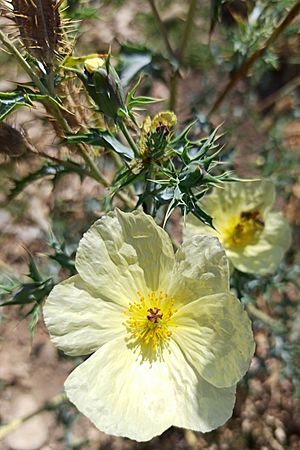Argemone ochroleuca facts for kids
Quick facts for kids Argemone ochroleuca |
|
|---|---|
 |
|
| Scientific classification | |
| Synonyms | |
|
Argemone ochroleuca is a type of prickly poppy. It is a flowering plant often called the pale Mexican prickly poppy or Mexican poppy. This plant originally comes from Mexico. However, it can now be found in many warm and mild parts of the world. It grows up to 1 meter (about 3 feet) tall. The plant has a sticky yellow sap inside its stems and leaves.
About the Pale Mexican Prickly Poppy
The pale Mexican prickly poppy is a plant that grows in many places. It is known for its pretty flowers and spiky leaves. The plant's name, "prickly poppy," comes from its sharp spines. These spines help protect the plant from animals that might want to eat it.
Where Does It Grow?
While this poppy is native to Mexico, it has spread to many other places. You can find it in Western Australia, New Zealand, and parts of the Middle East. It also grows in Iran, India, South Africa, and Arizona in the United States.
Why Is It a Problem?
In some areas, Argemone ochroleuca has become an invasive species. This means it grows very quickly and takes over areas where it is not native. It can push out local plants that belong there. This can make it harder for native plants and animals to survive.
- Lots of Seeds: This poppy makes many seeds. These seeds can easily travel to new places. Sometimes, they mix with seeds of farm crops. This can accidentally spread the poppy to new farms.
- Harmful to Farms: When it grows on agricultural land, it can become a weed. It competes with crops for water, sunlight, and nutrients. This can make it harder for farmers to grow their food.
- Affects Nature: The poppy can also harm biodiversity. Biodiversity means having many different kinds of plants and animals in an area. When the poppy takes over, it reduces the variety of life.
- Not Safe to Eat: It is important to know that this plant is not safe. It can be harmful to both humans and farm animals if eaten.
See also
 In Spanish: Argemone ochroleuca para niños
In Spanish: Argemone ochroleuca para niños

